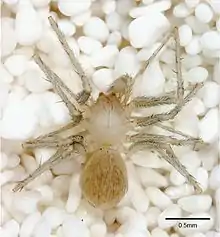Leptonetidae
Leptonetidae is a relatively primitive family of spiders first described by Eugène Simon in 1890.[1] It is made up of tiny haplogyne spiders, meaning they lack the hardened external female genitalia. Their six eyes are arranged in a semicircle of four in front and two behind. Many live in caves or in leaf litter around the Mediterranean, and in Eurasia, Japan and southern North America.[2]
| Leptonetids | |
|---|---|
 | |
| Tayshaneta anopica | |
| Scientific classification | |
| Kingdom: | Animalia |
| Phylum: | Arthropoda |
| Subphylum: | Chelicerata |
| Class: | Arachnida |
| Order: | Araneae |
| Infraorder: | Araneomorphae |
| Family: | Leptonetidae Simon, 1890 |
| Diversity | |
| 21 genera, 365 species | |
 | |
Genera
As of April 2019, the World Spider Catalog accepts the following genera:[2]
- Appaleptoneta Platnick, 1986 — United States
- Archoleptoneta Gertsch, 1974 — United States
- Barusia Kratochvíl, 1978 — Montenegro, Croatia, Greece
- Calileptoneta Platnick, 1986 — United States
- Cataleptoneta Denis, 1955 — Asia, Europe
- Chisoneta Ledford & Griswold, 2011 — United States, Mexico
- Darkoneta Ledford & Griswold, 2010 — North America, Central America
- Falcileptoneta Komatsu, 1970 — Japan, Korea
- Leptoneta Simon, 1872 — Europe, Asia, Algeria
- Leptonetela Kratochvíl, 1978 — Greece, Asia
- Longileptoneta Seo, 2015 — Korea
- Masirana Kishida, 1942 — Japan, Korea
- Montanineta Ledford & Griswold, 2011 — United States
- Neoleptoneta Brignoli, 1972 — Mexico
- Ozarkia Ledford & Griswold, 2011 — United States
- Paraleptoneta Fage, 1913 — Algeria, Italy
- Protoleptoneta Deltshev, 1972 — Europe
- Rhyssoleptoneta Tong & Li, 2007 — China
- Sulcia Kratochvíl, 1938 — Europe
- Tayshaneta Ledford & Griswold, 2011 — United States
- Teloleptoneta Ribera, 1988 — Portugal
See also
References
- Simon, E. (1890). Etudes arachnologiques.
- "Family: Leptonetidae Simon, 1890". World Spider Catalog. Natural History Museum Bern. Retrieved 2019-04-21.
Further reading
This article is issued from Wikipedia. The text is licensed under Creative Commons - Attribution - Sharealike. Additional terms may apply for the media files.
